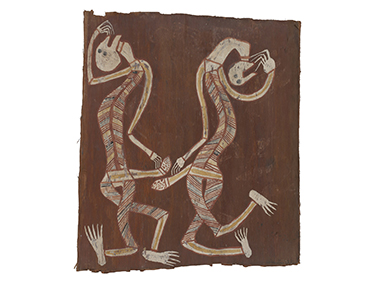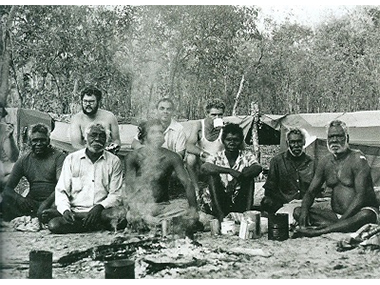'Him Proper Clever Man'

'Clever Man' The Life of Paddy Compass Namadbara, compiled by anthropologist Ian White
Jeremy Eccles | 08.01.21
Author: Jeremy Eccles
News source: Review
Paddy Compass Namadbara is just about a familiar name in Western Arnhemland bark art. In the 1950s and early 60s, he was part of a group that painted on Croker Island which included the future standout Yiriwala and Jimmy Mijaw Mijaw, and their work was noted for “dynamic movement and raw vigour, in which sexual imagery was made explicit” according to the NGV's Judith Ryan in 'Spirit in Land', her standard catalogue of Arnhemland art. Howard Morphy and Wally Caruana also list him in their encyclopedias of 'Aboriginal Art'.
But an awful lot of other books on bark art fail to appreciate Namadbara – perhaps because his aesthetic flowering was brief, and he had a much more important role to play in Kunwinjku life. As Ian White, senior anthropologist with the Northern Land Council and author of a new book from AIATSIS – 'Clever Man' - puts it, “He was a seer and a man attributed with considerable psychic or 'other-worldly' powers”. Using reports about the man, who lived between about 1898 and 1978, from seven fellow Kunwinjku seniors including Big Bill Neidjie and Thompson Yuludjiri, it's clear that “nobody with such stature and 'power' is (acknowledged to be) alive today”.
More important still, “Among his achievements, he devised a ritual to help the community believe in itself in the face of otherwise debilitating control by missionary and government authorities”.
And we should take on board the fact that Namadbara was born within a few years of the killing at Cape Brogden of an Indonesian prahu crew by his clansmen – for which the colonial authorities hanged his uncle publicly as an example of their newly arrived control.
It's very hard for non-tribal people to come to terms with the activities of such marrkidjbu – as 'clever men' are called in Kunwinjku. In the deserts they're called ngangkari – though I associate that group primarily with healing and, perhaps, a little sorcery.
In Namadbara's case, after what seems to have been almost eight years of ritual seclusion, including an observed 'out-of-body' experience and the attachment of two spirit children, he was qualified to lead ceremonies such as Mardayin, Uburr and Lorrkon, and he was witnessed healing, bringing a dead cat back to life, and giving both individuals and whole communities like Oenpelli real purpose. He revealed, and occasionally shared experiences of spirit travelling, using it to predict the arrival of people, of weather and natural changes, the existence of artesian water and the imminent death of others.
And, in the 50s, he made four major societal predictions.
Don't forget that the 50s were the era of assimilation before the 1967 Referendum. Yet he foresaw that “Aboriginal people would get paid, just like white fellas; that they would be bosses of their own land; and they would even own motorcars”. But then he added that this involvement in the capitalist economy “would result in serious fighting within the clan itself, threatening the cohesiveness and traditional clan structure”.
So Paddy Compass Namadbara – given the name Compass because he could always find his way in the densest bush, going on to survey new roads in Western Arnhemland and on the Coburg Peninsular, where his influence reached – was one hell of a lot more than a cheap conjuror. One might conclude that he was something of a psychotherapist, able to read people, give them a will to live or inspire them to believe in themselves – even if he did have to employ 'legerdemain' like speaking their dreams into a wooden box that was then buried in a drum with fat that slowly leached out as dreams became reality.
In Oenpelli, Namadbara devised a kumula ceremony where he called a meeting which began with song and dance as a lead up to people calling for housing in the town or land rights or simply the confidence to become a community leader.
White's book ends with acceptance that there was much that was inexplicable in Western terms. But he also throws in thoughts about eastern shamanism, Buddhist meditation techniques and offers links to Elizabeth Mayer's 'Extraordinary Knowing' and Stephen Hawking's 2018 speculation about a “holographic universe”. Of course there has to be reference to pioneering anthropologist AP Elkin's 1945 acceptance of the existence of such 'Men of High Degree'.
And I can't resist pointing out that the NPY Women's Council book on 'Traditional Healers of Central Australia' lists a lot of well-known artists' names – Ilawanti Ken, Maringka Burton, Pantjiti McKenzie. Jimmy Baker, Dickie Minyintiri, Nakul Dawson, Jacky Giles, etc. Could there be a connection?
Even in death, Namadbara appears special. He was invited to seek immortality – but declared “The Earth too strong; I can't break the law”.Ten years after his death, he appeared to join a white buffalo hunter – he'd been one himself - at his camp fire close to the billabong at Mangulwan where his spirit is assumed to rest. But at his burial place, an antbed/termite mound has grown up as evidence of his sacred power. Succeeding 'cleverman' are dismissed as “just witchdoctors – now we have the Church and the Health Clinic!”.
Oddly, Paddy Compass Namadbara is frequently remembered as “like Jesus”. And that perhaps justifies a connection to the late Gawirrin Gumana AM from eastern Arnhemland who was both a Lutheran pastor and achieved the ultimate rank Gamanungu Bukulup Ngarra in the Yolngu world. That's a spiritual grading that retired him from ritual responsibility in a ‘living wake’ and allowed him to confer authority on a new generation of leaders.
'Clever Man' is a slim book, but it contains a wealth of Arnhemland lore that justifies it's price (from AIATSIS) of $40.
URL: https://aiatsis.gov.au/whats-new/news/personal-stories-clever-man
Share this:
»  del.icio.us
»
del.icio.us
»  Digg it
»
Digg it
»  reddit
»
reddit
»  Google
»
Google
»  StumbleUpon
»
StumbleUpon
»  Technorati
»
Technorati
»  Facebook
Facebook
Contact Details

The sinuous and blatantly sexual image of 'Two Mimi Spirits dancing' (1963) by Paddy Compass Namadbara in the National Museum's collection

Namadbara on the far right clearly the leader of a meeting to establish the First Aboriginal Mining Company at Mt Borradaile. Pic by George Chaloupka
Further Research
Artists: Ilawanti Ken | Big Bill Neidjie | Dickie Minyintiri | Gawirrin Gumana | Jacky Giles | Jimmy Mijaw Mijaw | Maringka Burton | Nakul Dawson | Paddy Compass Namadbara | Pantjiti McKenzie. Jimmy Baker | Thompson Yuludjiri | Yiriwala
News Tags: Aboriginal Studies Press | AIATSIS | Ian White | Jeremy Eccles | marrkidjbu | Men of High Degree | ngangkari
News Categories: Blog | Book | Feature | Industry | News | OBIT
News Archive
- 11.01.21 | "Lost in Another Person's Culture”
- 08.01.21 | 'Him Proper Clever Man'
- 04.01.21 | Appreciating Mparntwe
- 21.12.20 | DYARUBBIN
- 14.12.20 | FOUR DAYS TO GO
- 09.12.20 | Museological Sydney
- 08.12.20 | Influential Aussies
- 03.12.20 | The Kelton Collection Heads to Switzerland
- 02.12.20 | Getting Back into the Habit in Sydney
- 27.11.20 | Putting the Cart Before the Horse?
- 25.11.20 | VICTORIA OPENS!
- 17.11.20 | Aboriginal Art Storms Online
- 10.11.20 | Michael Nelson Jagamara AM 1946 – 2020
- 10.11.20 | 'Nilimurra Dhuwal: Here We Are' by Guynbi Ganambarr
- 06.11.20 | GORDON BENNETT SOLO IN QUEENSLAND
Advertising

